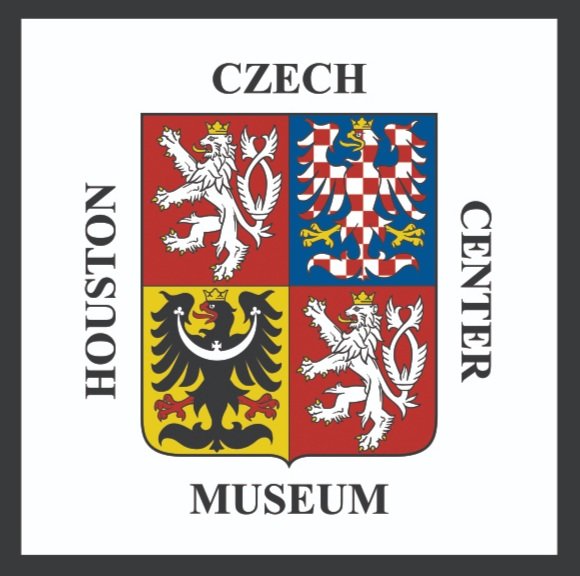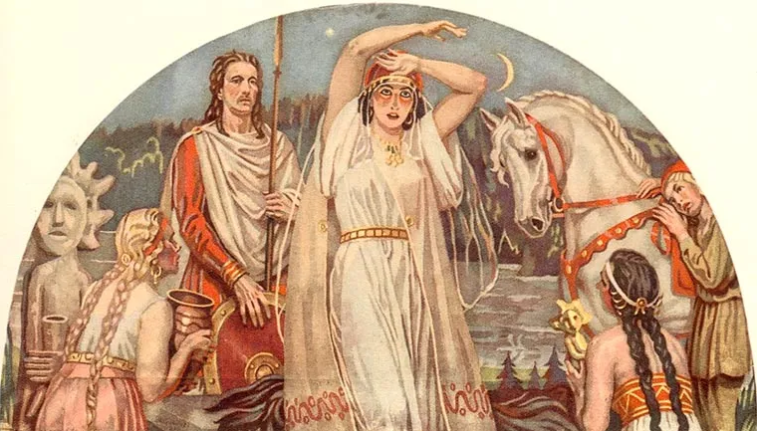Czech women have adapted to the status quo or attempted to shift it throughout history. To understand the shift in attitudes towards feminism and women’s roles, we must explore the broad picture of the culture and political and economic sphere as they change with time. It is also crucial to understand that, while feminism is understood as the belief in social, economic, and political equality of the sexes, Western feminism carries a different connotation. Aversion to Western feminism by Czechs is not an aversion to equality, it is a critique of the trajectory of feminism in the West.
Beginnings
Max Švabinský (1950) “Libussa prophesizes the glory of Prague”.
The Czechs have always had a rich history of women’s empowerment. Since the Slavic lands were predominantly agricultural, they were more egalitarian than most European countries because women did the same kind of work as men and were treated as partners. There were female rulers, such as Libuše, whose reign promoted prosperity and inspired folklore, and the well-known regent, Maria Theresa.
Battle of Hussites and Catholic crusaders,
Jena Codex, 15th century
Christianity shifted the role of women in society. Women were required to provide a dowry, or property or money brought to a husband by his bride, when they got married. Unlike in most European countries, women had greater rights to their dowry and there were protections against husbands squandering the assets. Infidelity was hardly punished for men, but it was a severe crime for women. This male domination is a result of patriarchal rule, or a society following male lineage where men hold the majority of power. Yet, Christianity paved the way for protections for women in other ways, with some covenants becoming social institutions and women's shelters.
During the Hussite wars, which followed the religious reformation, women showed bravery by helping men in battle and even taking their place. The Hussite Movement was characterized by an emphasis on equality and the demand that the Bible should be available in the language of the people. Education was allowed for men and women. With the defeat of the Hussites, women were relegated to the home. Their value was derived from how many male children they could have. Yet, they managed to keep Czech culture alive during this dark time by teaching their children traditions and secretly practicing the Protestant religion.
Antependium likely made by the Poor Clares of Cheb during the 14th century.
Then, in the Middle Ages, there were a multitude of educated queens. Women were also active during the "Golden Age" of Bohemian literature in the sixteenth century, but their artistic talents were most prevalent in embroidery. Women’s emphasis on education and art extended to the peasant class, and some women went from village to village teaching them how to read and write. This was important in reviving Czech culture and language.
The Maidens' War, painted by Adolf Liebscher
Despite the achievements of women, attitudes toward them have not always been positive. One of the most popular folk tales involving women is The Maiden’s War, a story about women who start a war to rebel against men, written in 1875. The war began after the men went to war without the women’s consent, a result of replacing their competent female leader, Libuše, with a rash male leader. This male leader, Přemysl, ended matriarchal society and replaced it with patriarchy. Women left their families to train for war against men, and men fought back by murdering female travelers to lure the leader into open combat. Though the women fought bravely, their leader, Vastala, was overconfident and led them to a traumatic defeat. The castle they trained at was burned and the women’s rebellion was annihilated. This story is symbolic of the attitudes toward women’s emancipation at the time. However, this is only one view of women’s roles in society, and it also demonstrates the immense threat women could pose against the patriarchy.
Paulina Krakowowa, 1882, Paulina Wilkońska, 1875, Ewa Felińska, printed in Lithography. M. Fajansa, 1851-1862, photo: National Library Polona
Before the 1948 communist coup, the feminist movement in the Czech Republic was vibrant. It took off during the National Revival period of the 18th and 19th centuries, a period where Czech culture began to thrive and Romanticism was embraced. Though women were still confined to a domestic role, there were multiple female writers during the Romantic Era, notably Bozena Némcová, and they fought against stereotypes about women and harsh criticism. Education for men and women was emphasized to preserve Czech culture, and unmarried women were allowed to find employment in a select few positions.
Františka Plamínková, a feminist suffragette
Since the beginning of Czechoslovakia, in 1918, women have had the right to vote and enjoyed civic protections. Women were elected to office and given political power virtually as soon as the nation was established. The first president of the Czech Republic, Tomás Gariggue Masaryk, crafted some of the first Czech feminist political writings and taught about women’s issues. He believed “The woman's problem is a human problem. Women and their work deserve respect and consideration. They represent half of the population of our new Republic." Women’s education also increased, with women being admitted to universities as “regular students” instead of special cases.
Communism
Women in Prague, 1956
During the communist period, autonomous women’s groups were banned. When women’s groups returned, they were entirely controlled by the government. The Czechoslovak Union of Women, an organization dedicated to the communist party, contributed to the distrust of women’s organizations in the future. State control of the government and economy led to men and women becoming allies in their opposition to the totalitarian regime. They worked together to avoid mandatory work and meet their own objectives.
However, the government did concern itself with women’s emancipation, largely to derive a massive labor force. It was believed, following Fredrich Engels’ hypothesis, that women’s equality would occur alongside the abolition of private property, socialization of housework and childcare, and equal employment opportunities. Gender discrimination in the workplace was prohibited, abortion was legalized, and maternity and childcare benefits were implemented. These strategies were designed to take the burden off of women and struggling families, giving them a greater opportunity to participate in the labor market. In effect, women still carried the burden of housework and childcare, but now they were required to take on greater labor. This idea of women’s emancipation was lacking, and it has garnered similar critiques to Western feminism due to its ‘artificial emancipation.’ Yet, many of the reforms in Czechoslovakia were ones Western feminists were fighting for, so Czech women were able to take for granted social benefits provided for women by the state.
Attitudes towards the West remained hostile, and Western feminism was labeled “bourgeois feminism” and given a host of negative stereotypes. It was labeled man-hating and desirous of any enemy. These negative attitudes still pervade modern society and attitudes toward feminism.
Post-Communism
After the Velvet Revolution, women’s emancipation became associated with the failed communist regime and was shunned due to feminism’s focus on class struggle, ties with socialism and communism, and the formation of a collective identity. The emphasis on “common experiences” in feminism is a reminder of the uniformity imposed by the communist regime, and it is contrary to the unique identities many Czechs desire. Though many autonomous women’s organizations were started, they often denied feminism, but feminist organizations are on the rise. Western feminism often concerns itself with ending the patriarchy and capitalism, which conflicts with the grievances of the social legacy of communism many people have. It is often viewed as a utopian concept, one rejected by many Czechs after the fall of communism.
Today, women carry the majority of the housework and still maintain full-time jobs, but the pay gap between men and women remains large. There is a sense of apathy in the feminist movement, with women placing their value on being able to do so much. Since there is a sense of pride in being a strong, capable woman, many women reject the “victim status” placed on women by Western feminism. While attitudes towards feminism are shifting in a more positive direction, there are still many arguments against it. Some believe it is destabilizing the traditional family structure, and others believe it is not doing enough to achieve equality.
Even though there have been steps towards equality, women hold a negligible amount of political and economic power, domestic and sexual violence policies are weak, maternal violence is far too common, and the availability of abortions has decreased. Feminism has passed through many phases, and there is still much work to be done to establish greater equality.
Written by Jaime Johnston
Citations
Dolansky, Marie, and Zora Fricova. “The Status of Czech Women - Then and Now.” THE STATUS OF CZECH WOMEN - THEN AND NOW - Český dialog, February 2001. https://www.cesky-dialog.net/clanek/270-the-status-of-czech-women-then-and-now/.
Drakulic, Slavenka. “How Women Survived Post-Communism (and Didn’t Laugh).” IWM WEBSITE. Accessed May 30, 2023. https://www.iwm.at/transit-online/how-women-survived-post-communism-and-didnt-laugh.
“Feminism.” Encyclopædia Britannica, May 15, 2023. https://www.britannica.com/topic/feminism.
Ferreira, Lou. “‘Sexual Liberation, Socialist Style’: An Overlooked Women’s Rights Story?” openDemocracy, October 3, 2018. https://www.opendemocracy.net/en/5050/sexual-liberation-socialist-style-overlooked-womens-rights-story/.
“Františka Plamínková: The Feminist Suffragette Who Ensured Czechoslovakia’s Constitution of 1920 Lived up to the Principle of Equality.” Radio Prague International, June 25, 2021. https://english.radio.cz/frantiska-plaminkova-feminist-suffragette-who-ensured-czechoslovakias-8106811.
Hanáková, Petra. “The Viscitudes of Czech Feminism.” Feminism in Czech Republic, 1998. https://www.cddc.vt.edu/feminism/cz.html.
Heitlinger, Alena. “Framing Feminism in Post-Communist Czech Republic.” Communist and Post-Communist Studies 29, no. 1 (1996): 77–93. http://www.jstor.org/stable/45301958.
Lemons, James. “Prophecies of Libuše.” Czech Center Museum Houston, January 27, 2021. https://www.czechcenter.org/blog/prophecies-of-libuse.
Siklova, Jirina. “Feminism and the Roots of Apathy in the Czech Republic.” SOCIAL RESEARCH 64, no. 2 (1997).
Sikolvá, Jirina. “Why Western Feminism Isn’t Working in the Czech Republic.” Feminism in Czech Republic, 1999. https://www.cddc.vt.edu/feminism/cz.html.
Zahradnicek-Haas, Elizabeth. “Czech Women’s Lobby: 6 Ways Czechia Is Still Failing Women in 2023.” Prague, Czech Republic, March 8, 2023. https://www.expats.cz/czech-news/article/6-ways-czechia-is-still-failing-women-in-2023.
Zeman, Josefa Humpal. “The Women of Bohemia.” Essay. In The Congress of Women, Held in the Woman’s Building, World’s Columbian Exposition, Chicago, U.S.A., 1893, edited by Mary Kavanaugh Eagle, 127–30. Chicago , Ill: Monarch Book Company, 1894.







